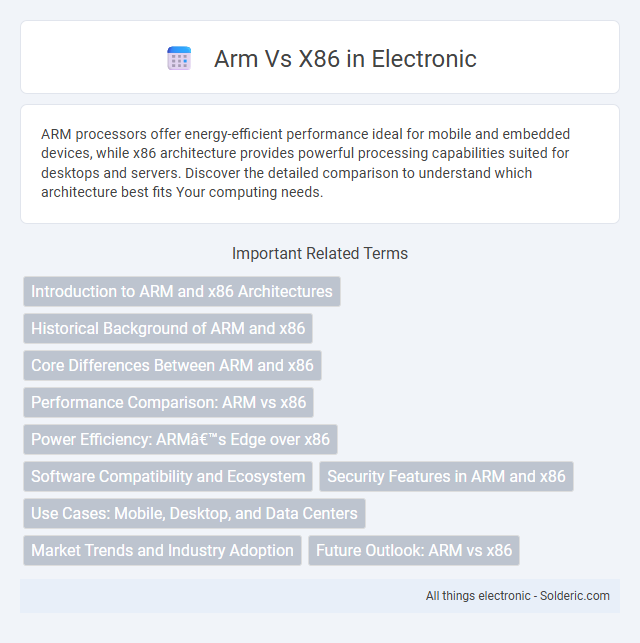ARM processors offer energy-efficient performance ideal for mobile and embedded devices, while x86 architecture provides powerful processing capabilities suited for desktops and servers. Discover the detailed comparison to understand which architecture best fits Your computing needs.
Comparison Table
| Feature | ARM Architecture | x86 Architecture |
|---|---|---|
| Instruction Set | RISC (Reduced Instruction Set Computing) | CISC (Complex Instruction Set Computing) |
| Power Efficiency | High (Optimized for low power consumption) | Lower (Typically higher power usage) |
| Performance | Efficient for mobile and embedded devices | High performance, favored in desktops and servers |
| Usage | Smartphones, tablets, embedded systems, IoT devices | Desktops, laptops, servers, high-end computing |
| Instruction Width | Fixed 32-bit (Thumb 16-bit for efficiency) | Variable (from 8-bit to 64-bit instructions) |
| Compatibility | Limited cross-platform software compatibility | Extensive software ecosystem and backward compatibility |
| Manufacturers | Qualcomm, Apple (M1, M2), Samsung, MediaTek | Intel, AMD |
| Market Share | Dominant in mobile and embedded markets | Dominant in PC and server markets |
| Security Features | ARM TrustZone, Pointer Authentication | Intel SGX, AMD SEV |
| Price | Generally lower-cost designs | Typically higher-cost processors |
Introduction to ARM and x86 Architectures
ARM architecture, known for its energy-efficient design, powers most mobile devices and embedded systems due to its RISC (Reduced Instruction Set Computing) principles. x86 architecture, developed by Intel, dominates desktops and servers with a complex instruction set (CISC) enabling high performance and backward compatibility. Your choice between ARM and x86 impacts device performance, power consumption, and software compatibility.
Historical Background of ARM and x86
ARM and x86 architectures originated in the 1970s and 1980s, with x86 developed by Intel as a powerful instruction set for personal computers, while ARM was designed by Acorn Computers to create energy-efficient processors for embedded systems. The x86 architecture gained dominance in desktop and server markets due to its backward compatibility and performance, whereas ARM's RISC-based design revolutionized mobile and low-power devices. Understanding this historical background helps you grasp why ARM excels in battery-sensitive environments while x86 remains prevalent in traditional computing.
Core Differences Between ARM and x86
ARM architecture features a reduced instruction set computing (RISC) design, emphasizing energy efficiency and simpler instructions, which leads to lower power consumption and longer battery life in mobile devices. x86 architecture employs a complex instruction set computing (CISC) approach with a wide range of intricate instructions, optimizing high performance and backward compatibility in desktops and servers. These fundamental architectural differences influence performance, power usage, and application suitability across computing platforms.
Performance Comparison: ARM vs x86
ARM processors typically excel in power efficiency and are optimized for mobile and embedded devices, delivering strong performance per watt. x86 architectures generally provide superior raw computational power and better multi-threading capabilities, making them preferable for high-performance desktops and servers. Benchmark comparisons reveal that while x86 dominates in sustained high-load tasks, ARM chips are rapidly closing the gap with improved architectures and increasing core counts.
Power Efficiency: ARM’s Edge over x86
ARM processors excel in power efficiency due to their reduced instruction set computing (RISC) architecture, which minimizes energy consumption by executing simpler instructions per cycle. This efficiency makes ARM chips ideal for mobile devices, embedded systems, and laptops where battery life and thermal management are critical. In contrast, x86 processors, designed primarily for performance with complex instruction sets, typically consume more power, limiting their efficiency in portable and low-power environments.
Software Compatibility and Ecosystem
ARM architecture offers broad software compatibility through extensive support for mobile and embedded applications, with major operating systems like Android and iOS primarily designed for ARM processors. x86 architecture dominates desktop and server ecosystems, ensuring compatibility with a vast array of legacy applications, Windows software, and enterprise solutions. The growing development of cross-platform tools and emulation layers, such as Apple's Rosetta 2, increasingly bridges compatibility gaps between ARM and x86 environments.
Security Features in ARM and x86
ARM architecture integrates TrustZone technology, providing hardware-isolated secure environments that enhance protection against various attacks. x86 processors incorporate Intel SGX (Software Guard Extensions), enabling application-level secure enclaves to safeguard sensitive data from unauthorized access. Both architectures support encryption and secure boot processes, but ARM's emphasis on energy efficiency also extends to security, making it favorable for mobile and IoT devices.
Use Cases: Mobile, Desktop, and Data Centers
ARM processors dominate mobile devices due to their energy efficiency and lightweight architecture, making them ideal for smartphones and tablets. x86 processors remain the standard in desktops and laptops, offering superior performance for complex computing tasks and compatibility with a wide range of software. In data centers, ARM is gaining traction for low-power, high-density servers, while x86 continues to lead in high-performance computing and enterprise applications.
Market Trends and Industry Adoption
ARM processors dominate the mobile and embedded device markets due to their energy efficiency and scalable architecture, with companies like Apple and Samsung extensively adopting ARM-based designs. x86 architecture remains prevalent in desktop, laptop, and server environments, driven by Intel and AMD's continuous advancements in performance and backward compatibility. Your choice between ARM and x86 should consider the growing ARM ecosystem for low-power applications and the established x86 infrastructure for high-performance computing needs.
Future Outlook: ARM vs x86
ARM architecture is projected to dominate mobile, embedded systems, and increasingly penetrate data centers due to its power efficiency and scalability. x86 remains strong in high-performance computing, gaming, and enterprise servers with continuous improvements in processing power and compatibility. Your technology choices will likely hinge on whether energy efficiency or raw computing strength aligns better with your future needs.
arm vs x86 Infographic

 solderic.com
solderic.com